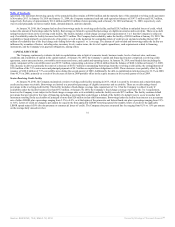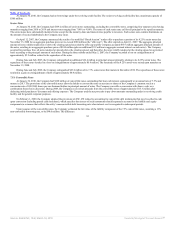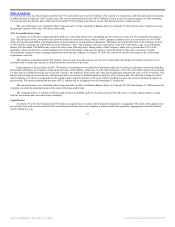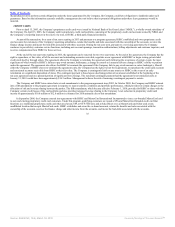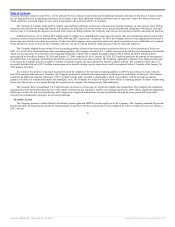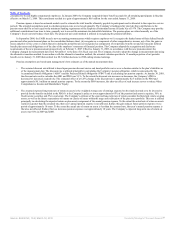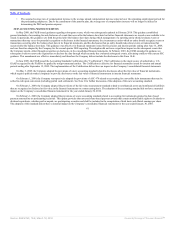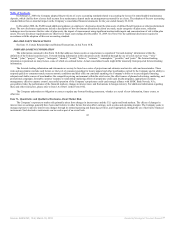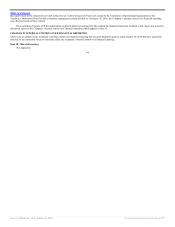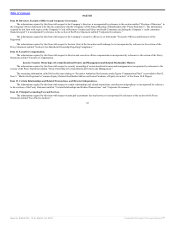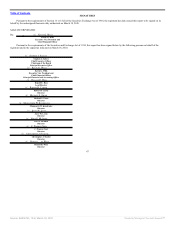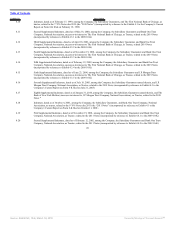Saks Fifth Avenue 2009 Annual Report Download - page 41
Download and view the complete annual report
Please find page 41 of the 2009 Saks Fifth Avenue annual report below. You can navigate through the pages in the report by either clicking on the pages listed below, or by using the keyword search tool below to find specific information within the annual report.
Table of Contents
valuation allowance related to state NOLs, will be realized. We will continue to assess the need for additional valuation allowance in the future. If future results
are less than projected or tax planning alternatives are no longer viable, then additional valuation allowance may be required to reduce the deferred tax assets
which could have a material impact on our results of operations in the period in which it is recorded.
The Company is routinely under audit by federal, state and local authorities in the areas of income taxes and the remittance of sales and use taxes. Taxing
authorities may question the timing and amount of deductions, the allocation of income among various tax jurisdictions and compliance with federal, state and
local tax laws. In evaluating the exposure associated with various tax filing positions, the Company often accrues for exposures related to uncertain tax positions.
Additional reserves of $1.1 million, $0.5 million and $1.8 million were established for issues raised in current state tax examinations and previously filed
federal tax returns related to prior periods during 2009, 2008 and 2007, respectively. At January 30, 2010, the Company believes it has appropriately accrued for
future exposures related to uncertain tax positions. To the extent the Company were to prevail in matters for which accruals have been established or be required
to pay amounts in excess of reserves, the Company’s effective tax rate in a given financial statement period may be materially impacted.
The Company adopted the provisions of new accounting guidance related to uncertain income tax positions effective as of the beginning of fiscal year
2007. As a result of the implementation of this accounting guidance, the Company recorded a $33.7 million decrease in the liability for unrecognized tax benefits
which was accounted for as an increase to the beginning shareholder’s equity. The Company had approximately $40.4 million and $46.0 million of gross
unrecognized tax benefits at January 30, 2010 and January 31, 2009, respectively. As of January 30, 2010, $35.0 million represents the amount of unrecognized
tax benefits that, if recognized, would impact the effective income tax rate in any future periods. The Company continually evaluates its tax filing positions and
to the extent the Company prevails on audits or statutes of limitation expire, the unrecognized tax benefits could be realized. The Company believes that it is
reasonably possible that up to $25.5 million in unrecognized tax benefits relating to prior acquisitions could be recognized within 12 months of the January 30,
2010 balance sheet date.
As a result of the analysis of uncertain tax positions upon the adoption of the relevant accounting guidance in 2007 the net deferred tax asset related to
state NOL carryforwards increased. Therefore, the Company performed a valuation allowance analysis to determine the realizability of this asset. This analysis
resulted in an additional valuation allowance of $19.3 million with the offset recorded to shareholders’ equity in accordance with the relevant accounting
guidance for entities in reorganization under the bankruptcy code. The Company was subject to the provisions of this accounting guidance for these net operating
losses since these losses were acquired through the acquisition of a company that had previously filed bankruptcy.
The Company files a consolidated U.S. Federal income tax return as well as state tax returns in multiple state jurisdictions. The Company has completed
examinations by the Internal Revenue Service or the statute of limitations has expired for taxable years through January 28, 2006 with no significant adjustments.
With respect to the state and local jurisdictions, the Company has completed examinations in many jurisdictions through the same period and beyond and
currently has examinations in progress for several jurisdictions.
PENSION PLANS
The Company sponsors a defined benefit cash balance pension plan and SERP for certain employees of the Company. The Company amended the pension
plan during 2006, freezing benefit accruals for all participants except those who have attained age 55 and completed 10 years of credited service as of January 1,
2007, who are
39
Source: SAKS INC, 10-K, March 18, 2010 Powered by Morningstar® Document Research℠




